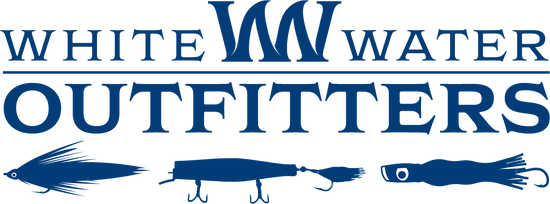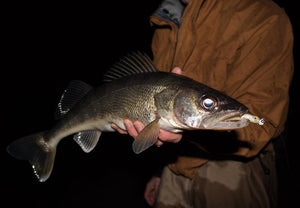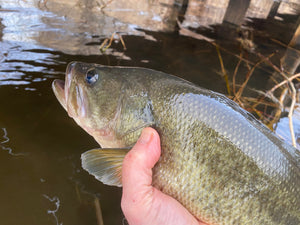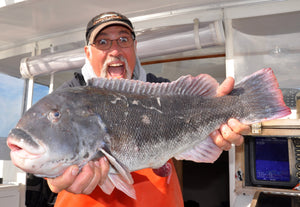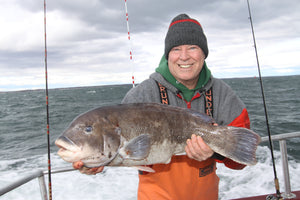Spring Preview, 2025: Shinnecock & Peconic Bays
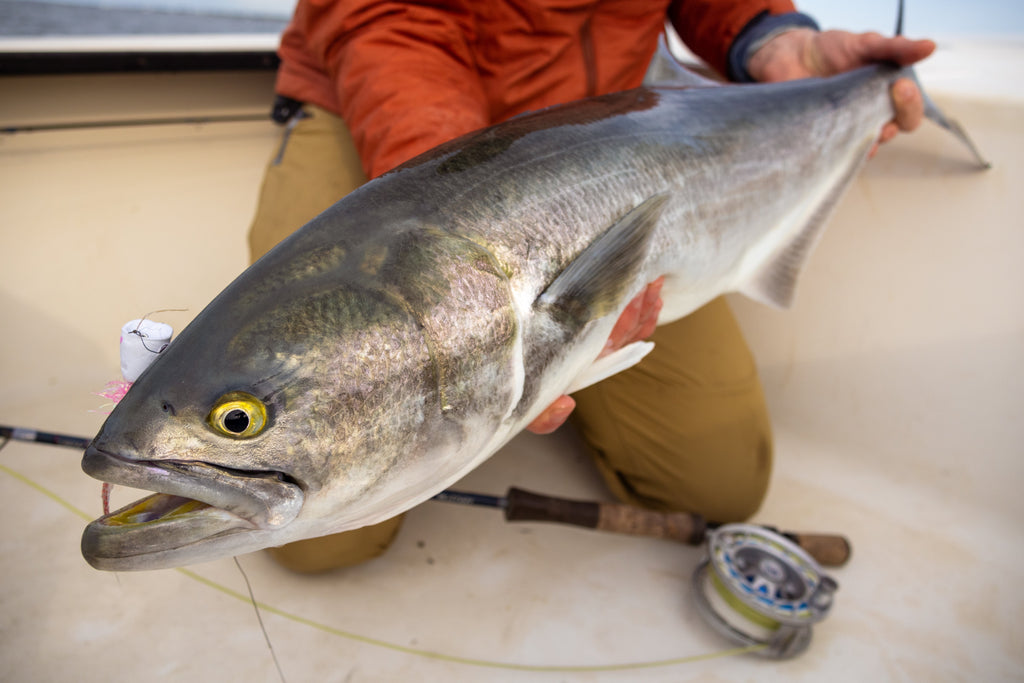
Big bluefish are mean fighting machines, especially when targeting them with a fly rod.
It seems like it’s been a long time coming but the 2025 inshore fishing season should be kicking into high gear soon. We’re lucky here at White Water Outfitters to be right in the center of the East End’s early spring bite. Flanked to the east by Shinnecock Bay, to the west by Peconic Bay and to the south by Shinnecock Canal, there’s just miles and miles of fantastic fishing opportunity only minutes from the shop. That allows us a good read on the early-season action as reports filter through the shop on a daily basis once things begin to get going.
With that thought in mind, here’s a preview of what we hope to see in our local bay waters as we progress through the spring season. The first significant action usually starts up in late April with schoolie stripers in the back bays and tidal creeks, followed by porgies, weakfish, and some big-headed “racer” blues by early to mid-May. Add a quick shot at blackfish, plus an assortment of other tasty critters like blowfish and kingfish, and you’ve got the makings of a great start to the new year.
As always before kicking off your new saltwater fishing season, be sure to sign-up for the mandatory but free Recreational Marine Fishing Registry. You’ll also want to peruse the Recreational Saltwater Fishing Regulations, too, as there are always a few changes from year-to-year. Note some changes may be posted immediately prior to the season so double-check them right before heading out on your initial trips. A beautiful spring striper that ate a Lefty's Deceiver. Spring fishing with the fly rod can be a great way to have more fun with schoolies!
A beautiful spring striper that ate a Lefty's Deceiver. Spring fishing with the fly rod can be a great way to have more fun with schoolies!
Fun With School Bass and Bruiser Blues
You know spring has arrived for real as the first reports of school stripers start making their rounds. The action in Shinnecock and Peconic Bays starts in the tidal creeks, Shinnecock Canal (at night), Quogue Canal, and the back bay waters at the end of April, spreading to the open flats and coastline waters in early May.
While schoolies are by far most numerous on this early bite larger fish – some easily topping 30” - do stalk these shallows, especially between Mother’s Day and early June. Look for those where channel waters border flats – or around bunker schools in deeper water if the big, silvery baitfish arrive in generous numbers. By late May, those bigger bass will be found on the back side of Shinnecock Inlet and in the South Race between Shelter Island and Northaven, too. As May rounds into June, bass fishing should build along the ocean beaches and in some of the heavy current traditional hot spots like Shinnecock Inlet and Plum Gut.
As a rule, it’s a good idea to keep your offerings a little bit on the smaller side when targeting bay bass early in the year. Topwater fans can score well throwing a Madd Mantis Plank 159. At 6.56” long, it’s smaller than the big Doc spooks or large swimbaits that work so well during the summer and fall, but it better matches the smaller baits you’ll find inside the bays this time of year. Yo-Zuri’s Top Knock Pencil, in a 4- or 5” size, is another great choice for those who prefer lightweight tackle. With sizes from 3” to 7”, it can cover the bases pretty well. We suggest the 4” size for action with the schoolies and, possibly, the season’s first weakfish. If you’d rather go with a soft-plastic swimbait for spring schoolies, consider the JYG Swym Paddletail. It’s a soft-plastic minnow imitation with an especially pleasing lifelike action that weakfish and bass both have trouble ignoring.
A quality outfit for spring schoolies, school blues and weakfish, too, would run along the lines of a 4000-size Daiwa BG MQ spinning reel matched to one of the new Tsunami Carbon Shield III rods we’ve just received. Other solid rod choices for spring bass action include the TFO Tactical Inshore, Shimano Teramar Northeast, and the St. Croix Premier series. There’s good price points with these setups and they’ll manage anything you hook inside the bays.
 If big spring “racer” blues suddenly vanish on Shinnecock or Peconic Bay, head for the nearest weakfish hotspot. It’s a good bet that’s where they’ll end up. OutdoorTom.com / Felicia Scocozza photo.
If big spring “racer” blues suddenly vanish on Shinnecock or Peconic Bay, head for the nearest weakfish hotspot. It’s a good bet that’s where they’ll end up. OutdoorTom.com / Felicia Scocozza photo.
Big Head Bruiser Blues
Those first big “racer” blues that arrive in our waters in early May arrive hot and heavy. They can run from 8- to 15 pounds or more but tend to be skinny along the flanks, thus the “big head” moniker. You’ll find them first at Shinnecock Inlet, but within days they’ll spread through the heart of Shinnecock Bay, through Shinnecock Canal, and into the deep waters and heavy rips in the Jessup Neck area of Peconic Bay.
Blues of just about any size can seriously challenge most reasonable bay gear, but racer blues often catch anglers by surprise with their fury and might. You can handle them with the bass gear noted above, but loosening up a bit on the drag wouldn’t be a bad idea. For the ultimate bluefish blast, consider targeting them on the surface with the long wand. A 9’, 9wt, fast-action choice like the Hardy Marksman Z, TFO Axiom II, or new Lamson Cobalt is ideal. Match any of these rods to a Hardy Fortuna Regent, Hardy Zane Carbon, Sage Spectrum or Waterworks-Lamson Remix reel loaded with a 9wt Rio Outbound Short floating fly line and it’s hard to go wrong when throwing a “Bob’s Banger” Popper Fly pattern. Switch from floating to an intermediate Rio Striped Bass Tapered Leader if you’d like to target big-shouldered school stripers or larger toss backs with this outfit as well.
If the racers have been feeding hard in their usual hot spots just inside Shinnecock Inlet or over at Jessup and then suddenly disappear, they may still be in the area. Just look for the nearest weakfish fleet. Big blues love school weeks and will chomp them in half as the sea trout cousins are reeled to the surface. If you can’t raise them on a fly here, consider dropping a diamond jig – but hold your rod extra-tight.
 Peconic Bay’s spring porgies are well-fed. Many are of the “humpbacked” variety. OutdoorTom.com photo.
Peconic Bay’s spring porgies are well-fed. Many are of the “humpbacked” variety. OutdoorTom.com photo.
Pork Chops Rule In May and June
No matter how you cut it, big porgies are the king of the hill these days for early spring action on Peconic Bay. The waters immediately east of Jessup Neck, Noyak Bay, Little Peconic Bay, the Greenlawn’s, and Robbins Rock team with big scup, some stretching the tape to 17” or more. Shore-bound anglers can score from parklands on the north side of Peconic Bay, at the north end of Shinnecock Canal (when the locks are closed), and from the Old Ponquogue Bridge access on Shinnecock Bay. Porgy action shifts to high gear by the first week in May and continues unabated into June before bay catches slowly slacken. Note that the biggest scup tend to be caught early in the season.
If you are new to finding scup we recommend you just look for the fleet. It’s reliably visible in most of the better spots on weekends, and not exactly inconspicuous during the week, either. Expect the action to be best in 12- to 30-foot depths, although it does shift deeper when fishing pressure is heavy.
Most porgy fans use pieces of clam or small strips of squid to score with scup, but you can also enjoy using a lightweight outfit and sparsely-tied ¾- to 1-oz. bucktail like the OG Jigs Big Eye Bucktail tipped with squid. A tubeless ¾- to 1.5-ounce single-hook diamond jig does the trick, too. A simple bottom rig is fine for catching pork chops one-at-a-time. A hi-low rig, though, increases your odds of double-headers, sometimes with a weakfish bonus. A thin strip of squid on the high hook and clam on the bottom is the time-honored offering where these two species share quarters.
Should you need a solid porgy setup, it makes sense to go the conventional route. For these waters, a size 15 or 20 Daiwa G Jigging or Saltist reel on a Jigging World Onyx inshore casting rod serves nicely as a universal bottom fishing outfit. It will handle the porgies with no problem and also best weakfish, fluke, blowfish, triggerfish or any other cellar dweller you encounter.
 Both Peconic and Shinnecock Bays offer a good shot at catching keeper-sized fluke. A simple fish strip and grub combo is one way to deck a few.OutdoorTom.com photo.
Both Peconic and Shinnecock Bays offer a good shot at catching keeper-sized fluke. A simple fish strip and grub combo is one way to deck a few.OutdoorTom.com photo.
Weakfish and Fluke Prospects
Weakfish and fluke have been the perennial question marks when it comes to local bay fishing over the past decade. The fluke action last year was slightly improved in both Peconic and Shinnecock Bays, and the longer summer flattie season instituted last year is likely to put a few extra fillets in angler’s coolers if a September bump occurs.
Following a stellar 2023 spring season, weakfish seemed to slip a bit during 2024. Hopefully, their upward trend will return this year. Noyak Bay, Southold Bay and Rodgers Rock are among the Peconic hot spots. For Shinnecock Bay, took to channel edges east of the inlet, as well as deeper holes between the Ponquogue Bridge and Quogue Canal.
For the summer flatties, action should begin in warmer, shallower, back-bay waters as the season opens in early May. The first three weeks of action probably offers your best shot to catch a doormat in either Peconic or Shinnecock bay. Bucktails tipped with squid, long squid strips, sea robin strips, and large Berkley Gulp! Saltwater Jigging Grubs are the offerings that seem to tempt the most keepers. Jig heads tipped with Berkley Gulp! Saltwater Swimming Mullets and spearing and squid combos have the edge if overall action is your desire. On Peconic Bay, the fish mostly move east from Jessup Neck and the Greenlawns toward the Oyster Factory and Bug light as the season advances. In Shinnecock Bay, fluke action usually starts on the flats and backtracks to the inlet as waters warm.
- Bryce Poyer
